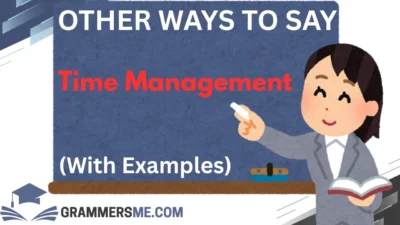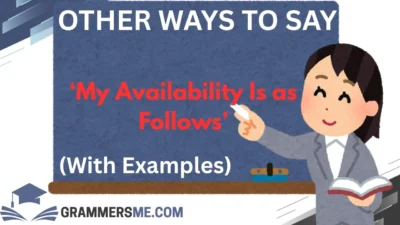When it comes to communication, the right choice of words can make a world of difference. Whether you’re sending a professional email, checking in with a colleague, or trying to sound a bit more thoughtful in your messages, knowing how to phrase things with warmth and care can turn an ordinary statement into a meaningful one.
This is especially true when you want to give someone a gentle heads up without sounding too abrupt. Below are 30 alternative ways to say “just a heads up”, with real-life examples, explanations, and tips on when each expression is best used. Let’s dive into it!
What Does “Just a Heads Up” Mean?
Before we explore the alternatives, let’s define “just a heads up”. This phrase is typically used to give someone a quick, informal warning or piece of information, usually about something important they need to be aware of, but without sounding too serious. It’s often used to set expectations or to make the recipient aware of something before it happens.
Is It Professional/Polite to Say “Just a Heads Up”?
Yes, “just a heads up” is generally considered polite and professional, though it can be seen as informal. Depending on your relationship with the recipient, this expression is often used in emails or messages to give a little nudge or share a quick update. However, in certain formal contexts, it might be more appropriate to choose one of the following alternatives to sound more polished.
1. Just So You Know
Meaning: A way of gently informing someone of something they may want to be aware of.
Explanation: This phrase is a softer, more neutral alternative. It can convey that the person doesn’t need to act on the information, but just to be aware of it.
Scenario Example:
“Just so you know, the meeting time has been changed to 2 PM tomorrow.”
Best Use: Ideal for sharing updates without any urgency.
Not Use: When the information is time-sensitive.
2. For Your Information (FYI)
Meaning: A formal or neutral way of giving someone information.
Explanation: Commonly used in both professional and casual settings, this phrase lets someone know something important, without implying that they need to do anything about it.
Scenario Example:
“FYI, the report deadline has been extended.”
Best Use: Ideal for emails or professional correspondence.
Not Use: In casual or overly personal conversations.
3. Just a Quick Note
Meaning: A friendly way of saying you’re about to share something brief.
Explanation: This phrase introduces information in a light, informal way, letting the recipient know it’s something that won’t take up much time to read or address.
Scenario Example:
“Just a quick note: the office will be closed for the holiday on Friday.”
Best Use: Perfect for casual emails or quick messages.
Not Use: When you need to convey important, formal information.
4. I Wanted to Let You Know
Meaning: A gentle and slightly more personal way to inform someone.
Explanation: It emphasizes that you’re sharing something with the person because you care and want them to be aware.
Scenario Example:
“I wanted to let you know that I’ll be out of the office next week.”
Best Use: Use when you want to add a personal touch to your message.
Not Use: When the message is strictly professional.
5. Just to Keep You Informed
Meaning: To ensure someone is up-to-date on a matter.
Explanation: This phrase can be used when you want to show the recipient that you are keeping them in the loop, without any immediate call to action.
Scenario Example:
“Just to keep you informed, we’ve made some changes to the project timeline.”
Best Use: When updating colleagues or clients on changes.
Not Use: If there’s no real new information to share.
6. Thought You Might Want to Know
Meaning: A casual and thoughtful way of presenting information.
Explanation: This is a more empathetic approach to saying “heads up,” offering the info in a friendly and non-intrusive way.
Scenario Example:
“Thought you might want to know, the server is undergoing maintenance this evening.”
Best Use: In casual or semi-formal situations.
Not Use: When you’re relaying critical, urgent information.
7. Just a Friendly Reminder
Meaning: A polite, warm way of reminding someone about something.
Explanation: This is commonly used for follow-up reminders. It’s slightly more friendly and less stern than a strict reminder.
Scenario Example:
“Just a friendly reminder that the team meeting is at 3 PM today.”
Best Use: When reminding someone of something small or routine.
Not Use: For major tasks or deadlines.
8. I Just Wanted to Give You a Heads Up
Meaning: A slight variation on “just a heads up,” used in more conversational situations.
Explanation: This variation puts a little more emphasis on your intent to be proactive in keeping someone informed.
Scenario Example:
“I just wanted to give you a heads up that the files will be sent over later this afternoon.”
Best Use: For emails or messages where you want to be more transparent.
Not Use: When you need to sound more formal.
9. Just a Quick Heads-Up
Meaning: A quicker, more casual way of saying “just a heads up.
Explanation: Similar to “just a heads up” but more direct and brief, making it ideal for quick updates.
Scenario Example:
“Just a quick heads-up, the presentation will be moved to 4 PM.”
Best Use: For short, to-the-point updates.
Not Use: When the information requires more context or explanation.
10. Wanted to Give You a Quick Update
Meaning: A clear, straightforward way of sharing the most current information.
Explanation: It’s useful when you’re updating someone on something that could affect them, without making the message feel too formal.
Scenario Example:
“Wanted to give you a quick update on the new process changes.”
Best Use: When conveying updates in a professional setting.
Not Use: In overly casual conversations.
11. Just a Little Heads Up
Meaning: A gentler way of saying you’re offering information or a warning.
Explanation: This is a softer version, implying that the information is not urgent but still important.
Scenario Example:
“Just a little heads up, the system will be down for maintenance tonight.”
Best Use: For informal, friendly communication.
Not Use: For urgent or critical information.
12. Here’s What You Need to Know
Meaning: A direct way of informing someone about something important.
Explanation: This approach cuts straight to the point, making it great for clear and concise communication.
Scenario Example:
“Here’s what you need to know: the deadline for the proposal has been moved to Friday.”
Best Use: For clear, no-nonsense updates.
Not Use: In sensitive or nuanced situations.
13. Just a Quick Reminder
Meaning: Similar to “just a friendly reminder,” it offers a gentle nudge.
Explanation: This phrase implies that the recipient might have forgotten something, but without sounding too forceful.
Scenario Example:
“Just a quick reminder to submit your timesheet by 5 PM today.”
Best Use: For casual follow-ups.
Not Use: For formal or urgent reminders.
14. Heads Up About
Meaning: A direct, concise way to give someone a warning or information.
Explanation: This one is useful when you want to share something you feel the recipient needs to be aware of, but in a straightforward manner.
Scenario Example:
“Heads up about the office being closed next Friday for maintenance.”
Best Use: When you want to be clear and concise without a lot of extra wording.
Not Use: When more context or explanation is necessary.
15. Just a Thought
Meaning: A casual, friendly way of sharing an idea or information.
Explanation: This phrase softens the delivery, making the message seem more like a suggestion rather than an instruction.
Scenario Example:
“Just a thought: you might want to start the report earlier since it’s due on Friday.”
Best Use: When offering a gentle suggestion or reminder.
Not Use: When the message requires a more urgent or formal tone.
16. I Wanted to Bring This to Your Attention
Meaning: A thoughtful way of saying you’re letting someone know about something important.
Explanation: This phrase can be used to show that you’re highlighting something that might need the person’s attention. It’s less abrupt than just saying “heads up” and feels more considerate.
Scenario Example:
“I wanted to bring this to your attention—the upcoming deadline for the project has been moved to Friday.”
Best Use: When sharing important, but not urgent, information.
Not Use: When the information is urgent and requires immediate action.
17. Just a Friendly FYI
Meaning: A warm, approachable version of the more formal “FYI.”
Explanation: This phrase adds a layer of friendliness, making it less stiff and more conversational.
Scenario Example:
“Just a friendly FYI, the event has been rescheduled to next week.”
Best Use: When you want to keep the tone light but still convey important information.
Not Use: In formal, high-stakes communication.
18. Wanted to Make Sure You Knew
Meaning: A way of making sure someone is informed.
Explanation: This phrase expresses your intent to ensure the other person is fully aware of the information without sounding overly directive.
Scenario Example:
“Wanted to make sure you knew that the meeting has been pushed to Thursday afternoon.”
Best Use: For situations where you want to ensure clarity and avoid any confusion.
Not Use: When urgency or deadlines are involved.
19. Just Giving You a Quick Update
Meaning: A casual way to provide someone with an update.
Explanation: This phrase works well when you’re sending out information that doesn’t require much explanation and is just for informational purposes.
Scenario Example:
“Just giving you a quick update: the office renovations are scheduled for next month.”
Best Use: When giving an update on something that doesn’t require immediate action.
Not Use: When the information is critical or needs detailed context.
20. Here’s a Heads-Up
Meaning: A straightforward and clear way to inform someone.
Explanation: This phrase is similar to “just a heads-up,” but it’s slightly more direct. It works well in both formal and informal settings.
Scenario Example:
“Here’s a heads-up about the new process we’ll be implementing starting next month.”
Best Use: When delivering information that’s important but not necessarily urgent.
Not Use: When the information is sensitive and requires a more formal tone.
21. A Quick Word of Caution
Meaning: A more cautionary way of providing a heads-up.
Explanation: This phrase is useful when you want to alert someone to potential issues or risks, while still being considerate.
Scenario Example:
“A quick word of caution: the traffic near the office has been heavy lately.”
Best Use: When you want to warn someone about possible problems without creating panic.
Not Use: When you don’t want to sound overly serious or alarmist.
22. Just Wanted to Alert You
Meaning: A more formal way to indicate you are notifying someone of something.
Explanation: This phrase conveys a bit more urgency than some of the softer alternatives, making it suitable for times when you need the person to pay attention, but it’s still polite.
Scenario Example:
“Just wanted to alert you that the deadline for submitting your report is tomorrow.”
Best Use: When you need someone to be aware of something important but not immediately.
Not Use: When the message is more casual or lighthearted.
23. Just Thought You Should Know
Meaning: A friendly, somewhat informal way of sharing information.
Explanation: This expression suggests that the information being shared is not critical, but still worthy of attention.
Scenario Example:
“Just thought you should know that I rescheduled our meeting for later this afternoon.”
Best Use: In informal conversations or when relaying news that doesn’t require an immediate response.
Not Use: In professional emails where a more direct approach is necessary.
24. Wanted to Give You a Heads-Up
Meaning: A variation of “just a heads-up,” with a slightly more conversational feel.
Explanation: This phrase is often used when you want to make someone aware of something important, without sounding too formal.
Scenario Example:
“Wanted to give you a heads-up about the changes to the schedule for tomorrow.”
Best Use: Perfect for casual workplace settings or friendly reminders.
Not Use: In very formal or corporate communication.
25. Just a Little Reminder
Meaning: A soft reminder, ideal for non-urgent updates.
Explanation: This phrase is a little less assertive than “just a reminder,” which makes it perfect for a light nudge without sounding forceful.
Scenario Example:
“Just a little reminder: the meeting starts at 10 AM tomorrow.”
Best Use: When offering a casual nudge or reminder.
Not Use: When the message is time-sensitive or critical.
26. Just Making Sure You’re Aware
Meaning: Ensures that someone is informed or aware of a situation.
Explanation: This is a more formal way of providing information to make sure the person knows something that could be relevant to them.
Scenario Example:
“Just making sure you’re aware that the parking lot will be closed for maintenance next week.”
Best Use: When you want to ensure someone is fully informed about a matter.
Not Use: When the message needs to be more conversational or personal.
27. Just Wanted to Let You In on Something
Meaning: A more personal and informal way of sharing information.
Explanation: This expression is friendly and suggests you are including the person in an update that they may find useful.
Scenario Example:
“Just wanted to let you in on something—there’s going to be a change to the team structure starting next month.”
Best Use: When sharing something that is more personal or confidential.
Not Use: When dealing with formal, professional correspondence.
28. Here’s What You Should Know
Meaning: A direct way of sharing essential information.
Explanation: This phrase is often used to share key facts, without any fluff or unnecessary detail.
Scenario Example:
“Here’s what you should know: the deadline for submitting the proposal is next Monday.”
Best Use: For important information that the recipient needs to know immediately.
Not Use: When a more conversational tone is needed.
29. Just Want to Keep You Posted
Meaning: A way of keeping someone updated on an ongoing matter.
Explanation: This phrase is great for situations where the information is constantly changing, and you want to keep the recipient in the loop.
Scenario Example:
“Just want to keep you posted: we’re still waiting for the final approval on the project.”
Best Use: When you want to offer ongoing updates in a casual, approachable way.
Not Use: When the information is finalized or set in stone.
30. Wanted to Share This with You
Meaning: A warm, friendly way to inform someone of something important.
Explanation: This phrase is useful when you want to share something that’s useful or interesting without it feeling like an obligation.
Scenario Example:
“Wanted to share this with you—there’s a new tool available that could help with your project.”
Best Use: When sharing helpful information in a casual or semi-formal context.
Not Use: When urgency is involved or more formal language is needed.
Conclusion
Choosing the right way to communicate can turn a simple message into something more thoughtful, approachable, and impactful. By using one of these 30 alternatives to “just a heads up,” you can offer information in a way that feels more personal, warm, and considerate, no matter the context.
Whether you’re sending a professional email, checking in with a friend, or updating a colleague, these phrases will help you convey your message in a more empathetic and effective way.
FAQs
1. Can I use these alternatives for both personal and professional communication?
Yes! Many of these alternatives are versatile and can be used in both formal and informal contexts, depending on your tone and audience.
2. How do I know which phrase to choose?
Consider the formality of the situation and the relationship with the recipient. For formal situations, lean toward phrases like “For your information” or “Just wanted to make sure you’re aware.” For casual communication, phrases like “Just a quick note” or “Just a heads-up” are perfect.
3. Are these alternatives more polite than “just a heads up”?
Some of them are slightly more formal or warmer, making them ideal for situations where you want to convey information thoughtfully and politely.
4. Can these phrases be used in text messages?
Absolutely! Many of these phrases are perfect for quick updates via text, making your message feel more personal and friendly.
5. Is it okay to use these phrases in a professional setting?
Yes, as long as the tone matches the formality of the situation. You might want to avoid overly casual phrases in very formal settings, but most of these alternatives can work in a wide range of professional contexts.




